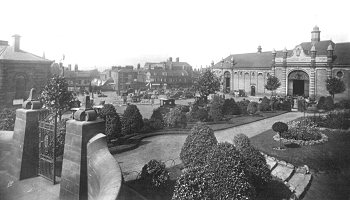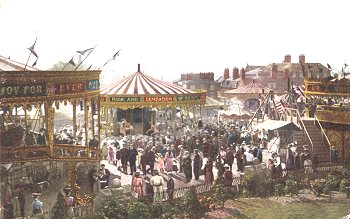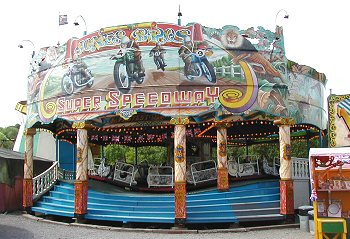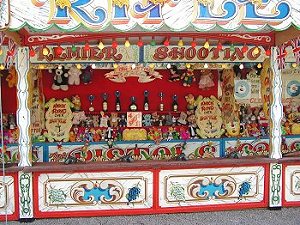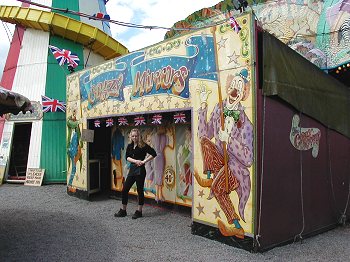On Whit Monday 1893 a reporter on Wolverhampton's weekly paper thought he would come into the office to take advantage of the public holiday to catch up with some work. He expected the town to be empty as the weather was fine and the railway companies had laid on many excursion trains to whisk Wulfrunians away for a day by the seaside. Public bank holidays were a new thing - as were large urban populations with disposable income that could be spent on pleasure. Coming into Wolverhampton at nine o'clock he was amazed to find the town full of people and bustling with activity. Two events were drawing vast crowds - the horseracing at Dunstall and the funfair built up on the market patch: the latter probably being visited on the way to and from the former! Both events attracted street traders and hawkers - particularly Italian ice-cream sellers from Salop Street, and gypsies from the Besom Yard. Ice cream was something of a novelty and was known as "hokey-pokey". It could be bought for half an old penny. Another recent innovation was the travelling photographic booth. Several of these surrounded the fair and long queues of Wulfrunians waited to have their "likeness" reproduced by the latest technology - providing they could sit still long enough for the image to be formed.
The market square was full of large steam powered riding machines of the latest types - there were "Mountain Ponies" that tore up and down hills and vales as they swept round; there was the "Sea on Land" which was such a violent ride it was guaranteed to make you sea sick as you sat in your little boat tossed on mechanical waves; there was the "Roley-Poley" or "Razzle Dazzle" which threw you about like a pancake in a frying pan while it gyrated; and there were the majestic "Gondolas", covered in carved and gilded woodwork revolving on a switchback track. Even swings had been enlarged and mechanised - the "Steam Yachts" were not for wimps! Some of these machines were lit by electricity, a "marvel" in 1893.
Had our observer stayed on the market patch after the fair had closed he would have noticed another "marvel". An army of men appeared from nowhere and quickly and efficiently dismantled every piece of equipment, loaded everything systematically onto wagons. Numerous teams of horses appeared and took the loaded wagons to the railway goods yard, or left Wolverhampton by road. By the next day the market patch was cleared and ready to reopen as the town's retail market. Never once did our reporter ask the name of anyone involved in this business - these people who came from nowhere opened a huge fair on Saturday and Monday and had gone again by Tuesday. Ladies from St. Peter's Church had tried to get to know the fairground folk by inviting wives to attend a tea party on Sunday afternoon in the new "institute" built on the corner of Exchange Street, and the showmen were familiar faces to many local tradesmen. But in all other respects they were anonymous.
Towns had assumed responsibility for leasing fairs as local government organisation and legislation developed as the nineteenth century progressed.
In Wolverhampton Pat was allowed to hold his fair on the market patch at Easter, Whitsun, and for a period running from Christmas to New Year. Every year through the 1880s, 1890s and 1900s these fairs became bigger and better. Pat loved to organise a spectacular event and always invested in the latest, fastest and biggest attractions. Towards the end of the 1900s he brought his huge bioscope (travelling cinema) shows to Wolverhampton. In May 1908 a reporter wrote: "Again the fine organ of Pat Collins is the outside attraction at his large cinematographic show, and the fit up of the concern, together with his attendants, attired in black frock coats and silk hats, offer a completeness so neat and artistic that, from a monetary point of view also, success is at once ensured. Besides he has his full equipment, with his racing motor cars, cockerels, horses, looping the loop etc.".
In Wolverhampton the fair began a period of being shunted around by a Council that offered various poor sites between Broad Street, Falkland Street and Stafford Street. Ultimately the firm gave up coming to Wolverhampton, creating something of a vacuum in the fairground world. By now other family firms were waiting to move in. In particular the Jones Family had started appearing in local parks, supporting local carnivals etc. It is now the Jones Family that bring the fairs to Wolverhampton, opening several times a year in West Park, as well as East Park, Wednesfield, Bee Lane etc. The closest the Pat Collins firm now comes is his annual appearance at the end of June in Hickman Park, Bilston. |




